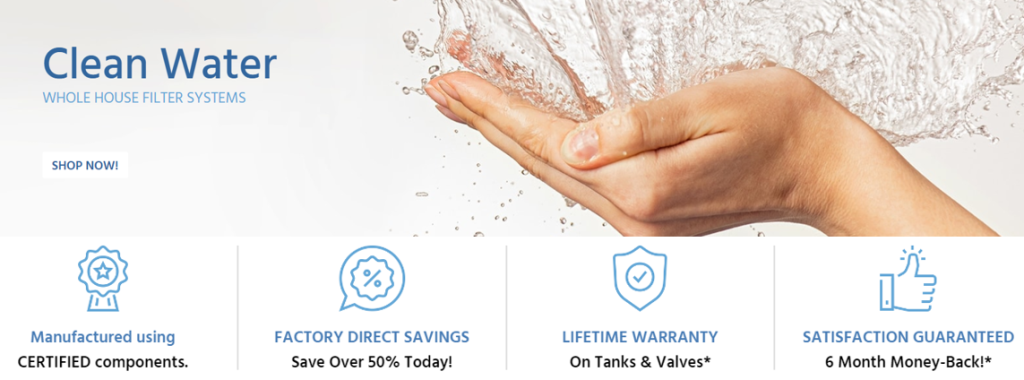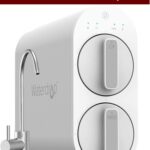Water softeners work by adding sodium ions to the water.
In 2004, the city of Toledo, Ohio, faced a crisis when its drinking water became contaminated with toxins. The city’s water treatment plant was not equipped to remove the toxins, and residents were advised to boil their water before drinking it.
In response, the city installed water softeners in all of its schools and public buildings. The water softeners remove minerals from the water, including sodium, which can bind to the toxins and make them more difficult to remove.
The installation of the water softeners was a success, and the city’s drinking water is now safe for consumption.
Install a Home Water Filter & Get "Unlimited Safe Drinking Water" For Decades
Get Upto 55% Discount With a Lifetime Warranty & 6-Months Money Back Guarantee Free Shipping
SpringWell Water Filtration Systems: 100% American-Made & NSF Certified Water Filters and Water Softeners
What Is A Water Softener?
A water softener is a device that is used to remove hard water minerals from water.

A water softener is a device that is used to remove hardness minerals from water. Hard water is water that contains high levels of calcium and magnesium. These minerals can cause a variety of problems, such as making it difficult to get soap to lather, leaving spots on dishes and clothing, and causing plumbing problems.
Water softeners work by exchanging the hardness minerals in water for sodium or potassium ions. This process is called ion exchange. The water softener will have a tank that contains a bed of ion exchange resin. As water flows through the tank, the hardness minerals attach to the resin. This leaves the water with a high concentration of sodium or potassium ions.
The water softener will also have a brine tank. The brine tank contains a salt solution. When the resin becomes full of hardness minerals, it must be regenerated. This is done by flushing the resin bed with the salt solution. The high concentration of salt ions will cause the hardness minerals to detach from the resin and be flushed out of the system.
Water softeners are a great way to improve the quality of your water. They can remove the hardness minerals that can cause problems with soap lathering, spots on dishes and clothing, and plumbing problems.
How Does A Water Softener Work?
A water softener removes minerals from water, making it softer.
If your home has hard water, it probably has a water softener. But how does a water softener work?
Water softeners remove minerals from hard water, making it softer. Hard water contains high levels of calcium and magnesium, which can cause buildup on pipes and fixtures and make it difficult to get soap to lather. Water softeners remove these minerals by exchanging them for sodium or potassium ions.
The most common type of water softener is the ion exchange water softener. This type of water softener works by exchanging ions in the water with ions on the surface of the water softener’s beads. The beads are made of a material that is attracted to the calcium and magnesium ions in the water. As the hard water passes through the water softener, the beads attract and hold onto the calcium and magnesium ions. At the same time, the water softener releases sodium or potassium ions into the water.
The result is water that is softened because it no longer has high levels of calcium and magnesium. And the water softener’s beads are regenerated and ready to remove calcium and magnesium from more hard water.
Ion exchange water softeners are the most common type of water softener, but there are other types, too. One is a reverse osmosis water softener, which uses a semipermeable membrane to remove minerals from water. Another is a magnetic water softener, which uses magnets to reduce the hardness of water.
If you have hard water, a water softener can make your water softer and help reduce buildup on your pipes and fixtures.
What Are The Benefits Of Using A Water Softener?
The benefits of using a water softener are that it can remove hard water minerals from your water, which can extend the life of your appliances and plumbing fixtures, and make your skin and hair feel softer.
If your home has hard water, you may have noticed some negative effects it can have on your home and appliances. Water hardness is caused by high levels of minerals, such as calcium and magnesium, in your water. These minerals can build up in your pipes and appliances, causing damage and decreased efficiency.
A water softener is a device that removes these minerals from your water, making it softer. There are many benefits to using a water softener, including:
1. Softer water is easier on your skin and hair.
2. It can extend the life of your appliances by preventing mineral buildup.
3. It can save you money on soap and detergent costs.
4. Soft water can make your home more energy-efficient.
If you’re considering a water softener for your home, be sure to talk to a professional to find the best option for your needs.
How Does A Water Softener Add Sodium To Drinking Water?
A water softener adds sodium to drinking water by adding salt to the water.
If your drinking water comes from a well, there’s a chance it contains hard water minerals such as calcium and magnesium. These minerals can cause Scale buildup in your plumbing and appliances and make your water feel “hard.” A water softener is a appliance that removes these minerals from your water, making it feel softer.
How does a water softener work?
Water softeners work by exchanging the hard water minerals for sodium ions. As the hard water passes through the water softener, the mineral ions are attracted to the positively charged sodium ions. This exchange process continues until the hard water minerals are all removed from the water.
Is sodium added to my drinking water?
The sodium ions that are exchanged for the hard water minerals are eventually flushed out of the water softener and into your home’s plumbing. This means that there is a small amount of sodium in the water that comes out of your taps. However, the amount of sodium added to your water is not enough to make it unsafe to drink.
If you are on a low-sodium diet, you may want to avoid drinking water that has been softened. You can ask your water softener manufacturer for more information about the sodium content of their products.
In conclusion, water softeners work by exchanging the hard water minerals for sodium ions. This process adds a small amount of sodium to your drinking water. However, the amount of sodium added to your water is not enough to make it unsafe to drink.
Are There Any Health Risks Associated With Drinking Water That Has Been Softened With A Water Softener?
No, there are no health risks associated with drinking water that has been softened with a water softener.
There are a few health risks associated with drinking water that has been softened with a water softener. The most common is that the softened water can leach lead from old pipes. This can cause health problems, particularly for young children and pregnant women. Another health risk is that the softened water can strip away natural minerals from the body, which can lead to dehydration. Finally, some people believe that the chemicals used to soften water (such as salt) can be harmful to health. However, there is no scientific evidence to support this claim.
FAQ
How Often Does A Water Softener Need To Be Replenished With Salt?
What Are Some Of The Other Ways To Soften Water?
Is It Possible To Remove Sodium From Water That Has Been Softened With A Water Softener?
It is hoped that you are now clear. If you still have any questions, please do not hesitate to comment below: “How do water softeners add sodium to drinking water?”


